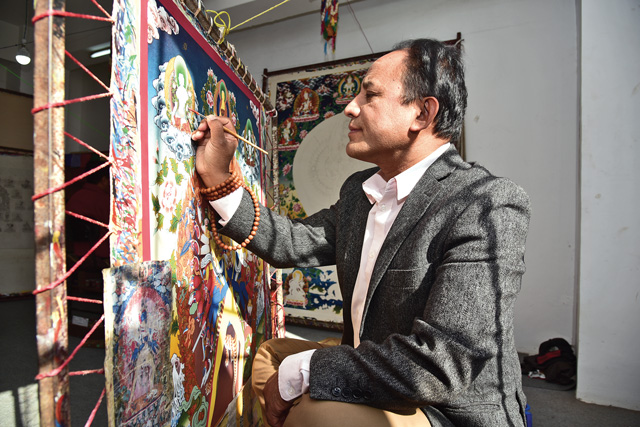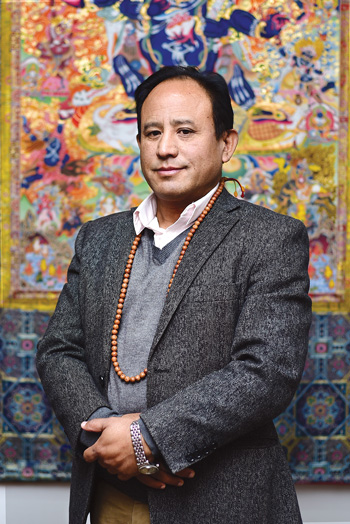A four-storey commercial building at Hattisar is the last place you would expect a thangka school to be. Still, when I visited the school, I expected to find a doorway covered with the kind of traditional Tibetan curtains you see in gombas, and a big, fancy signboard with the school’s name, “Dharmapala Thangka Center” on top. But, looking for the school turned out to be like searching for the mystical Shangri-La. You might get the directions and know where you’re headed, but if you fail to concentrate on the little things around you, you’ll miss it. I was running around looking for the school in the building, when it suddenly struck me, “Was that door on the ground floor always there?” So, when I peeped inside the plain looking door, sure enough, it was the school!

Run by a 9th generation thangka painter, Karsang Lama, the school was built in 1980 after he and his grandfather first visited Kathmandu. Both were born in a village called Rishanko in Sindupalchok. The village was famous for its thangka artists and clay and wood artisans. Lama learned to paint at the age of five at the local monastery, where his grandfather was the monk. When his grandfather came to Kathmandu, he saw thangka paintings being sold in the tourist area of Jhonchhen, but to his disappointment, most of them didn’t seem to carry any aesthetic value. It was then that he decided to settle his grandson in Kathmandu to open up a school for thangka artists.
“A thangka has an essence, a philosophy that needs to be understood before you begin painting one,” says Lama. Currently, his school teaches forty students, but the school is not only limited to the main office at Hattisar. There are two other schools located in Maharajgunj and Bhaktapur. He also owns a shop at Durbarmarg that sells the thangkas painted in his schools. Although these schools are taught by artists who have studied under Lama himself, he regularly visits the three locations to check up on his students.
 Since the establishment of the school, many students have learned under Lama, but to follow his teachings is not an easy path. Unlike other thangka schools in the valley, Dharmapala Center not only teaches artists how to paint a thangka, but it also requires the students to acquire extensive knowledge on Buddhist philosophies through meditational practice and study. Lama encourages his students to read Buddhist scriptures to understand the meaning behind their creations. For him, thangka art is not just about copying an image of a deity, but it is about being able to visualize the imagery through deep meditation. “That is how a thangka should be made,” he says. Through his school, he seeks to preserve the authentic and ancient techniques of the art.
Since the establishment of the school, many students have learned under Lama, but to follow his teachings is not an easy path. Unlike other thangka schools in the valley, Dharmapala Center not only teaches artists how to paint a thangka, but it also requires the students to acquire extensive knowledge on Buddhist philosophies through meditational practice and study. Lama encourages his students to read Buddhist scriptures to understand the meaning behind their creations. For him, thangka art is not just about copying an image of a deity, but it is about being able to visualize the imagery through deep meditation. “That is how a thangka should be made,” he says. Through his school, he seeks to preserve the authentic and ancient techniques of the art.
“Things have changed since the time I learned thangka painting,” he says. “During those days, I was required to live with my teacher in the gomba and study there for years.” He encourages his students to take retreats in rural villages. In order to become a thangka master, a student must take hermitage in remote villages, isolated from society, only visited by their spiritual master to guide them. He believes that when the student meditates in isolation, only then can he realize what he seeks to depict through his painting. They say that when one meditates, one can see the images of deities and the colorful aura they emit. This is what the artists portray through their canvases. Thangka painting is a specialized art form, and as Lama says, “Art requires the artists to be able to express themselves through their canvas. Thangka requires the artist to understand the subject matter; for that you need inspiration.” But this path is a road less taken, even among his students. Very few have been able to achieve this level of mastery through dedicated study.
“In today’s digital era, the young generation has a very difficult time believing in faith and devotion,” he explains. He is concerned that thangka is turning into a dying art. Despite the countless pieces of art being sold in many tourist areas, he states that artists aren’t as devoted to the ancient techniques of painting anymore. According to him, an authentic thangka has three features—the iconography of the deity, traditional paint made from natural minerals and plants, and the artist’s deep meditation on the subject. He insists that his students follow these three aspects strictly.
As for the future, he hopes he can build an institution and publish books on the art of thangka. He believes it is his duty to save the dying art, and he seeks to work for the preservation of the ancient technique. “A thangka painter is a happy man, because he gets to offer Dharma through his work,” he declares, adding, “I am a happy man because I get to teach the young generation who will keep this art alive in the days to come.”










